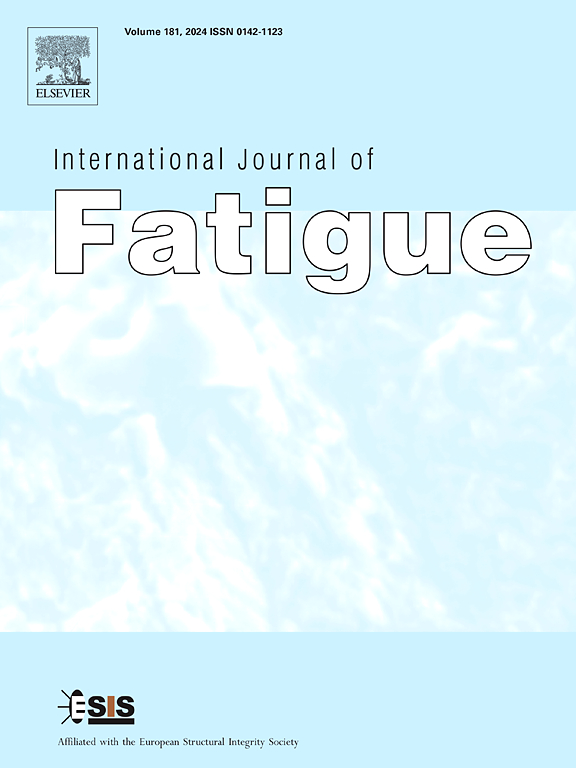残余应力对球墨铸铁轧制接触疲劳的影响
IF 6.8
2区 材料科学
Q1 ENGINEERING, MECHANICAL
引用次数: 0
摘要
采用实验和分析相结合的方法对球墨铸铁(DI)的滚动接触疲劳行为进行了研究。对DI在扭转疲劳和RCF下的疲劳行为进行了评价。在峰值压力为3.6 GPa的条件下,采用3个球-杆测试平台对DI的RCF进行了评估。使用MTS测试装置进行扭转疲劳测试,以确定材料的应力寿命(S-N)响应。采用洛氏硬度计测定DI材料的整体硬度,采用纳米压头测定DI RCF棒沿深度的硬度分布。采用x射线衍射(XRD)测量了RCF试验前后的残余应力,以评价残余应力对疲劳寿命的影响。XRD结果显示,经过RCF测试后,压缩残余应力增加了32%,表明塑性诱发残余应力,从而提高了抗疲劳能力。为了进一步验证实验结果;采用连续损伤力学有限元(CDM-FE)模型进行疲劳寿命预测。利用扭转疲劳S-N数据,得到了用于CDM框架损伤演化方程的材料常数。将不同的残余应力曲线作为材料深度的函数纳入模型,并对相应的RCF寿命预测进行了评估。分析结果与试验结果吻合较好,证实了残余应力对疲劳性能的影响。采用双参数Weibull分布表征DI材料的失效概率,表明其RCF性能与高强度钢相当,但略低于高强度钢。本文章由计算机程序翻译,如有差异,请以英文原文为准。
Effects of residual stress on rolling contact fatigue of ductile iron
This study investigates the rolling contact fatigue (RCF) behavior of ductile iron (DI) using experimental and analytical method. The fatigue behavior of DI was assessed under both torsion fatigue and RCF. The RCF of DI was assessed by a 3 ball-on-rod test rig at a peak pressure of 3.6 GPa. Torsion fatigue tests were performed using an MTS test setup to determine the material’s stress-life (S-N) response. A Rockwell hardness tester was utilized to determine the global hardness of DI materials, while a nano indenter was employed to obtain the hardness distribution along the depth of the DI RCF rods. X-ray diffraction (XRD) was employed to measure the residual stresses prior to and after RCF testing to assess the effect of residual stresses on fatigue life. XRD results revealed a 32% increase in compressive residual stress after RCF testing, suggesting plastic induced residual stresses, which in turn enhanced fatigue resistance. In order to further validate the experimental findings; a continuum damage mechanics finite element (CDM-FE) model was employed for fatigue life prediction. The material constants used in the damage evolution equation of the CDM framework were obtained using torsion fatigue S-N data. Different residual stress profiles as a function of the depth of the material were incorporated into the model, and the corresponding RCF life predictions were evaluated. The analytical results demonstrated good corroboration with the experimental results, confirming the significance of residual stress in influencing fatigue performance. A two-parameter Weibull distribution was utilized to characterize the DI material’s probability of failure, demonstrating that its RCF performance is in par but slightly lower to that of high-strength steel.
求助全文
通过发布文献求助,成功后即可免费获取论文全文。
去求助
来源期刊

International Journal of Fatigue
工程技术-材料科学:综合
CiteScore
10.70
自引率
21.70%
发文量
619
审稿时长
58 days
期刊介绍:
Typical subjects discussed in International Journal of Fatigue address:
Novel fatigue testing and characterization methods (new kinds of fatigue tests, critical evaluation of existing methods, in situ measurement of fatigue degradation, non-contact field measurements)
Multiaxial fatigue and complex loading effects of materials and structures, exploring state-of-the-art concepts in degradation under cyclic loading
Fatigue in the very high cycle regime, including failure mode transitions from surface to subsurface, effects of surface treatment, processing, and loading conditions
Modeling (including degradation processes and related driving forces, multiscale/multi-resolution methods, computational hierarchical and concurrent methods for coupled component and material responses, novel methods for notch root analysis, fracture mechanics, damage mechanics, crack growth kinetics, life prediction and durability, and prediction of stochastic fatigue behavior reflecting microstructure and service conditions)
Models for early stages of fatigue crack formation and growth that explicitly consider microstructure and relevant materials science aspects
Understanding the influence or manufacturing and processing route on fatigue degradation, and embedding this understanding in more predictive schemes for mitigation and design against fatigue
Prognosis and damage state awareness (including sensors, monitoring, methodology, interactive control, accelerated methods, data interpretation)
Applications of technologies associated with fatigue and their implications for structural integrity and reliability. This includes issues related to design, operation and maintenance, i.e., life cycle engineering
Smart materials and structures that can sense and mitigate fatigue degradation
Fatigue of devices and structures at small scales, including effects of process route and surfaces/interfaces.
 求助内容:
求助内容: 应助结果提醒方式:
应助结果提醒方式:


